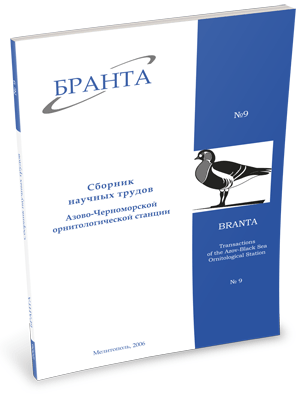
Transactions
of the Azov-Black Sea Ornithological Station



Seasonal dynamics of numbers and distribution of gulls in Southern Crimea.
M.M. Beskaravayny.
Gulls are one of the most diverse and numerous groups of hydrophilic Crimean birds. In the south of the region they occupy an important place in hydrophilic ornithocomplexes. The paper considers species composition, seasonal dynamics and numbers of species. The role of main landscape-biotope elements is estimated.
Material and methods. Studies were taken in 1976-2005 at the southern coast, in mountains and foothills of the Crimea. Material was mainly collected at a section of the coast Sevastopol-Feodosia ( near 240 km) or at some inner water bodies. There were used quantitative counts of nests and birds: route counts - along the coastline (280 counts) and local counts (1,500) were in areas of bird aggregations; migration intensity was studied at fixed points (about 70 hours of observations). To identify composition of the diet for two bird species (Black-headed Gull, Yellow-legged Gull) there were analyzed 4,581 pellets.
Brief characteristics of the investigated area. The area is a region of the mountaneous Crimea. The southern coast is the warmest, the sea is not covered with ice. Main types of vegetation are steppes, forest-steppes and forests. Freshwater areas are represented by storage lakes, the largest natural water body is LakeBarakol'. Artificial habitats cover considerable area (agricultural lands, settlements). Among settlements there are 10 cities.
Species composition. There are given data on a type and timing of stay, numbers and habitat distribution for 18 species: Stercorarius parasiticus, Larus ichthyaetus, L.melanocephalus, L.minutus, L.ridibundus, L.genei, L.fuscus, L.cachinnans,L.canus, Rissa tridactyla, Chlidonias niger, C.leucopterus, C.hybrida, Gelochelidon nilotica, Hydroprogne caspia,Thalasseus sandvicensis, Sterna hirundo, S.albifrons.
Main features of seasonal dynamics. Gulls are observed in the South Crimea throughout the year, but only Larus cachinnans breeds there ( resident). In the spring period there are recorded 15 species, mostly on their spring passage (usually Larus melanocephalus, L.ridibundus, L.genei, L.fuscus, L.cachinnans, L.canus, Thalasseus sandvicensis); on summer movements there are 11 species (usually Larus melanocephalus, L.cachinnans, Thalasseus sandvicensis);
late summer and autumn - 12 species (usually Larus melanocephalus, L.minutus,L.ridibundus,L.cachinnans, Thalasseus sandvicensis); in winter - 12 (usually Larus melanocephalus, L.ridibundus, L.cachinnans, L.canus).
Features of spatial distribution and usage of habitats. Range of habitats includes 1) coastal-marine zone (terrestrial relief, coastal water area): there are observed 17 migrating and wintering species, considerable concentrations are formed in winter near coastal cities; breeding habitats of Larus cachinnans; 2) inner water bodies (12 species): constructions of storage lakes improved feeding conditions for migrating and wintering birds; 3) watersheds: dumps are used as feeding habitats (4 species); in less degree - arable lands, steppe and forest-steppe areas (only Larus cachinnans). Natural and anthropogenic landscape-territorial objects, vitally important for bird activity, are determined.
Conclusion
In the South Crimea 18 species of gulls (Lari) were registered. Most of them (excepting Larus cachinnans) do not breed in the region, but use it as a migratory corridor, wintering grounds and during summer movements. Main breeding and feeding habitats are terrestrial forms of the relief and coastal marine water area. Over the last years anthropogenic landscape elements became of great importance, then 11 species are related to them. Relevant ecological and behavioral adaptations can be seen in an expanding range of breeding and feeding habitats, diet, forming directions of feeding migrations.
In 1970- 90s it was observed a decrease in numbers of wintering gulls (Larus genei, L.minutus, L.ridibundus, L.melanocephalus). Watering of the Crimea resulted in appearance of some migrating species, which had not been registered earlier (Sterna hirundo, S.albifrons, Chlidonias niger, C.leucopterus, C.hybrida).
Read the paper in a PDF file